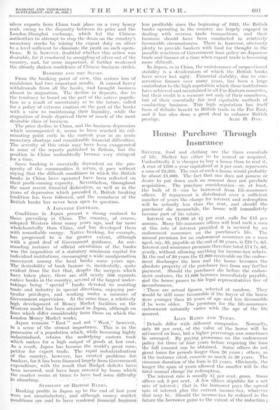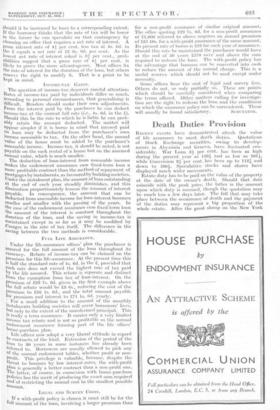House Purchase Through Insurance
SHELTER, food and clothing are the three essentials of life. Shelter has either to be rented or acquired. Undoubtedly it is cheaper to buy a house than to rent it. A rent of £100 a year capitalised at 3 per cent. represents a•sum. of £8,338. The cost of such a house would probably be about £1,000. The fact that one does not possess or desire to put down such an amount does not preclude acquisition. The purchase consideration—or, at least, the bulk of it—can be borrowed from life-assurance offices. It' repayment is distributed over a sufficient number of years the charge for interest and redemption will be actually less than the rent, and should the purchaser die meanwhile, the house will immediately • become part of his estate. Interest on £1,000 at 44 per cent. calls for £45 per annum. Many lik-assurance, offices. will lend such a sum at this rate of interest prokided it is 'secured by an endowment assurance on the purchaser's life. The Annual premium for an endowment assurance io!n a man aged, say, as, payable at the end of 30 years, is £29-7s. 6d. Interest and assurance premium therefore total £74 7s. 6d. dearly, without allowing anything for income-tax rebate. At the end of 30 years the £1,000 receivable On the endow- inent discharges the loan and the house becomes the litsolute property "of the ptirchaser free frOM any payment. Should the purchaser die before the endow- ent matures, the £1,000 becomes immediately payable, • d the house passes to-his legal representatives free of itcumbrances.
These are actual figures, selected at random. They *ould be 'still more favourable if the buyer of the house were younger than 35 years of age and less favourable if he were older. The premium for the life-assurance endowment • naturally varies with the age of the life ' assured. LOAN RATES AND TERMS.
Details differ with different companies. Normally, ly 80 per cent. of the value of the house will be a vanced on loan, but a higher percentage can sometimes be arranged. By paying premiums on the endowMent policy for three or four years before requiring the loan the full amount can be obtained. Some offices do not , grant loans for periods longer than 20 years ; others, as the instance cited, concede as much as 30 years. The common duration of the loan is 25 years. Obviously, the longer the span of yearn allowed the smaller will. be the total annual charge for redemption. The interest rate is usually 44 per cent. gross. Some Offices ask Vper :cent. A. few eaves ,stipulate for a :net rate of interest ; that is, the borrower pays the agreed rate of interest plus the current income-tax, whatever that may be. Should the income-tax be reduced in the future the borrower gains to the extent of the reduction ;, should it be increased he loses to a corresponding extent. If the borrower thinks that the rate of tax will be lower in the future he can speculate on that contingency by choosing an office that requires a net rate of interest. A gross interest rate of 4i per cent. less tax at 4s. 6d. in the £ equals a net rate of £3 9s. 9d. per cent. As the lowest net rate of interest asked is 3/ per cent., prob- abilities suggest that a gross rate of 4i per cent. is likely to prove the more advantageous. Most offices fix the rate of interest for the duration of the loan, but others reserve the right to modify it. That is a point to be kept in mind.
INCOME-TAX GAINS.
The question of income-tax deserves careful attention. Rates of income-tax paid by individuals differ so much, according to personal circumstances, that generalising is difficult. Readers should make their own adjustments. From the interest paid by the purchaser he can deduct Income-tax at the current full rate (i.e., 4s. 6d. in the £). Should this be the rate to which he is liable he can prob- ably retain the amount deducted. The matter will appear simpler if it is borne in mind that interest paid on loan may be deducted from the purchaser's own income assessable to tax. On the other hand, the annual value of the house must be added to the purchaser's assessable income. Income-tax, it should be noted, is not Payable on the rack rental of a house but on the assessed annual value, which is much smaller. The deduction of loan-interest from assessable income Makes the endowment assurance cum fixed-term loan a more profitable contract than the method of repayment of mortgages by instalments, as favoured by building societies. Under the instalment plan, the amount of loan outstanding at the end of each year steadily diminishes, and this diminution proportionately lessens the amount of interest Payable. In consequence, the amount that can be deducted from assessable income for loan-interest becomes smaller and smaller with the passing of the years. In the case of the endowment assurance cum fixed-term loan the amount of the interest is constant throughout the duration of the loan, and the saving in income-tax is maintained except in so far as it may be modified by 1-langes in the rate of tax itself. The difference in the sav4ig between the two methods is considerable.
FULL LIFE ASSURANCE.
Under the life-assurance offices' plan the purchaser is assured for the full amount of the loan throughout its Currency. Rebate of income-tax can be claimed on the Premium for this life-assurance. At the present time this is half the standard rate of 4s. 6d. in the £, provided that by rate does not exceed the highest rate of tax paid lay the life assured. This rebate is separate and distinct from the exemption from tax of loan-interest. On the Premium of £29 7s. 6d. given in the first example above the full rebate would be £8 6s. reducing the cost of the Premium to £26 ls. 6d., and tlie total amount payable for premium and interest to £71 ls. 6d. yearly. , Poi a small addition to the amount of the monthly but building societies will cover borrowers' lives, 9ot only to the extent of the unredeemed principal. This IS really a term assurance. It carries only a very limited income tax rebate and is not so profitable as the normal house-purchase assurance forming part of the life offices' oouse-purchase plan. Life offices now adopt a very liberal attitude in regard to contracts, of the kind. Extension of the period of the loan to 80 years in some instances has already been referred to. Borrowers are usually allowed to pick any of the normal endowment tables, whether profit or non- profit. This privilege is valuable, because, despite the threat to bonuses by low interest-rates, the with-profit plan is generally a better contract than a non-profit one. 411e latter, of course, in connexion with house-purchase Policies has the merit of producing the exact sum required and'of restricting the annual cost to the smallest possible amount.
LEGAL AND SURVEY COSTS.
If a with-profit policy is chosen it must still be for the '411 amount of the loan, involving a larger premium than for a non-profit assurance of similar original amount: The office quoting £29 7s. 6d. for a non-profit assurance of £1,000 referred to above requires an annual premium of £85 10s. for a with-profit assurance of the same amount. Its present rate of bonus is £19 for each year of assurance. Should this rate be maintained the purchaser would have at the end of 80 years £570 over and above the sum required to redeem the loan. The with-profit policy has the advantage that bonuses can be converted into cash to reduce the amount of the annual charge. This is a useful reserve which should not be used except under necessity. Some offices bear the cost of legal and survey fees. Others do not, or only partially so. These are points which should be carefully considered when comparing the terms offered. Other matters calling for investiga- tion are the right to redeem the loan and the conditions on which the assurance policy can be surrendered. These



























































 Previous page
Previous page